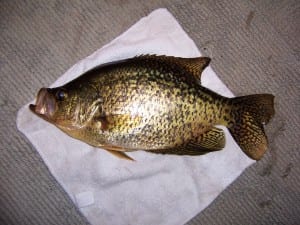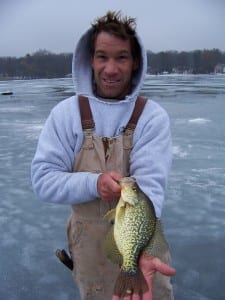Ohio Pond Management
Increasing Fish Production
Methods of Increasing Fish Production
Fertilization
Artificial Feeding
Adding Fish Habitat Structures
Pond owners should view their ponds as selfsustaining bodies of water that are capable of providing all of the ingredients necessary for good fish production. The amount of fishes that can be harvested depends upon a pond’s ability to produce them, and this amount varies from pond to pond. Ohio ponds can often support up to 250 pounds of fish per acre, although this amount is generally less for ponds that are smaller than one acre. If a pond’s normal fish production is less than what the pond owner deems acceptable, it may be possible to enhance production.
The most effective methods to artificially increase fish production are pond fertilization and fish feeding (pellet feeding pictured). However, each of these methods can also cause pond problems, so pond owners should consider them only after carefully weighing the trade offs associated with trying to increase fish production.
Fertilization
Fertilization can improve fish production by increasing the production of tiny plants and animals at the bottom of the food chain, the phytoplankton and zooplankton. This increase in production at the bottom of the food web may ultimately translate into improved growth and production of sport fish. However, negative impacts from fertilization can also result if the added nutrients stimulate growth of undesirable types of aquatic vegetation and algae. Whereas excess vegetation can be a problem to anglers and swimmers during warm weather months, it can also make the pond more susceptible to fish kills due to a build-up of dead and decaying plant material. The pond owner may find that the cost of fertilizer, effort to maintain a fertilization program, and risk of fish kills outweigh the benefits of the increase in fish harvested.
Most ponds in Ohio are adequately supplied with nutrients from the surrounding watershed and should not require artificial fertilization. In fact, many ponds receive so many nutrients from the watershed alone that problems develop with growth of excess vegetation and reductions in water quality. The following criteria should be met if a pond is to be considered for fertilization: 1) the watershed to pond ratio is less than 20 acres of watershed per surface acre of pond, 2) the watershed consists primarily of woodland acreage with soils that are low in fertility, and 3) the pond has a minimal amount of shallow water and most of the shoreline has the recommended 3:1 slope to discourage the growth of aquatic vegetation. Ponds without these characteristics should not be fertilized.
If fertilization is appropriate, then the pond owner needs to proceed with the proper treatment applied on a careful schedule. The recommended procedure is monthly applications of liquid fertilizers 10-34-0 (N-P-K) applied at the rate of two gallons per surface acre. Treatments should begin when water temperatures reach 60°F in the spring, and stop when water temperatures drop below 60°F in the fall. Fertilization should be temporarily halted when water temperatures exceed 80°F during the summer. Dilute each gallon of fertilizer with 10 gallons of water and spray the mixture evenly over the pond surface. Water clarity is a simple and convenient way to measure the progress of a fertilization program. The water clarity should be monitored twice each month throughout the fertilization season. This is easily accomplished by simply lowering a white object into the pond, such as a coffee mug on the end of a string. The white object should be visible to at least 18 inches below the water’s surface. If the object is not visible down to 18 inches, overfertilization may be a problem. In this case, postpone the next fertilizer treatment until the water has cleared somewhat and remeasure water clarity.
Artificial Feeding
Feeding is the most direct and reliable method to increase production of bluegills and channel catfish in ponds that are less than five acres. Proper artificial feeding will increase fish growth and provide larger fish for anglers. Unlike fertilization, with artificial feeding all of the nutrients go directly into fish production rather than the complex food chain. For ponds less than five acres, feeding is a feasible way to increase fish production. Bluegills and channel catfish will readily eat pelleted feeds that are available at agricultural feed stores. Pellet feed containing at least 25 to 32 percent protein will produce the best growth. Largemouth bass prefer live natural foods and will seldom eat pelleted feed.
Training fishes to accept artificial pellets may take a few days. When bluegills are feeding on the surface in the evening, tossing a few floating pellets into the areas where they are feeding will teach them to eat pelleted food. Begin an artificial feeding program by feeding fish about two pounds of pellets per acre per day. This amount may be increased to 15 pounds per acre per day after they have become accustomed to being fed. The feeding rate should be adjusted in the summer according to how much the fish are eating. Feeding may slow or even cease during the summer if water temperatures get above 85°F.
The best guide to feeding fishes is to give them no more than they can eat in 15 to 20 minutes. Using floating pellets in a feeding ring is a good way to monitor how much food they are eating. A feeding station approximately three feet in diameter can be constructed by sealing the ends of a piece of corrugated field tile. Connect the ends after sealing to form a three-foot circle and place the tile in an area of the pond that can easily be reached to fill with food (pictured right).
A pond owner should be willing to make a long-term commitment to continue feeding before a feeding program starts. Feeding should begin in the spring when water temperatures reach 60°F and should stop in the fall when water temperatures drop to 60°F. Fish should be fed daily at approximately the same time and in the same place. Missing a few days of feeding while on vacation will not cause problems if feeding is consistent during the remainder of the summer. Overfeeding fish can cause many of the same problems as overfertilization. Food that is not eaten by fish will decompose and use up the pond’s dissolved oxygen (see fish kills). Decomposing food can also release nutrients into the water that may promote the growth of aquatic vegetation and algae.
Adding Fish Habitat Structures to the Pond
Habitat structures –“fish shelters,” or “fish attractors”– are primarily designed to concentrate fish and increase an angler’s chances of success. Depending upon the size and type of materials used, structures can provide cover, resting areas, and feeding areas. Habitat structures can act as substitutes for natural cover in ponds where these types of areas are lacking.
Habitat structures can be constructed from many different natural and man-made materials. Easily obtained materials such as discarded Christmas trees can be banded together, weighted and sunk, although trees such as oak, hickory, and cedar work best due to their resistance to decay (brush pile picture right) . Man-made materials such as PVC pipe, field tile, concrete block, and wooden pallets can also be fashioned into fish attracting devices. Habitat structures can be placed into the pond from the bank if the structures are not too large and there is relatively deep water near the shore. Larger structures can be placed from a boat to allow access to deeper water.
Winter ice cover provides an excellent opportunity to build and place structures too large to install from the shore or by boat. These structures can be built on the ice, or built on shore and dragged out onto the ice. In either case, the structure is placed on the ice and allowed to fall into the desired location when the ice melts (see brush piles on ice to the right).
Fishes & anglers alike will make the best use of habitat structures that are distributed carefully in the best locations. These structures are best placed in water that is within reasonable casting distance from shore & two to eight feet deep to allow consistent fish use. Habitat structures should not be placed in the deepest part of the pond where low dissolved oxygen levels (common during summer) make them inaccessible to fish.

